BGM-71 TOW
The BGM-71 TOW ("Tube-launched, Optically tracked, Wire-guided")[6] is an American anti-tank missile. TOW replaced much smaller missiles like the SS.10 and ENTAC, offering roughly twice the effective range, a more powerful warhead, and a greatly improved semi-automatic guidance system that could also be equipped with infrared cameras for night time use.
| BGM-71 TOW | |
|---|---|
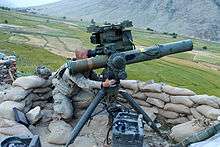 An M41 tripod-mounted TOW ITAS-FTL with PADS of the U.S. Army in Kunar Province, Afghanistan in May 2009. | |
| Type | Anti-tank missile |
| Place of origin | United States |
| Service history | |
| In service | 1970–present |
| Used by | See Operators |
| Wars | Vietnam War Third Indochina War 1982 Lebanon War Soviet–Afghan War Iran–Iraq War Gulf War War in Somalia (1992–1993) War in Afghanistan[1] Iraq War Syrian Civil War[2] Iraqi Civil War (2014–2017)[2] Yemeni Civil War (2015–present) Saudi Arabian-led intervention in Yemen Conflict in Najran, Jizan and Asir |
| Production history | |
| Designer | Hughes Aircraft Company |
| Designed | 1963–1968 |
| Unit cost | $93,640 (2B Aero), $54,956 (Bunker Buster) FY2021[3] £8,500 (1984)[4] |
| Specifications | |
| Length | 1.16–1.17 m (probe folded) 1.41–1.51 m (probe extended, some variants have no probe) |
| Diameter | 152 mm |
| Warhead weight | 3.9–6.14 kg (penetration 430-900mm RHA)[5] |
| Wingspan | 0.46 m |
Operational range | Basic TOW 3,000 m, most variants 3,750 m |
| Maximum speed | 278–320 m/s |
Guidance system | Optically tracked, wire-guided (Wireless Radio-guided in RF variants) |
First produced in 1970, TOW is one of the most widely used anti-tank guided missiles.[7] It can be found in a wide variety of manually carried and vehicle-mounted forms, as well as widespread use on helicopters. Originally designed by Hughes Aircraft in the 1960s, the weapon is currently produced by Raytheon.
Design and development
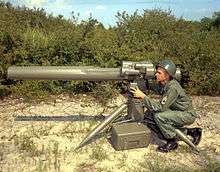
Initially developed by Hughes Aircraft between 1963 and 1968, the XBGM-71A was designed for both ground and heliborne applications. In 1997, Raytheon Co. purchased Hughes Electronics from General Motors Corporation, so development and production of TOW systems now comes under the Raytheon brand.[8] The weapon is used in anti-armor, anti-bunker, anti-fortification and anti-amphibious landing roles. TOW is in service with over 45 militaries and is integrated on over 15,000 ground, vehicle and helicopter platforms worldwide.
In its basic infantry form, the system breaks down into a number of modules: a folding tripod mount, a launch tube (into the rear of which encased missiles are inserted), a mandatory daysight tracker unit, which can be augmented with an optional AN/TAS-4 or AN/TAS-4/A gas-cooled night sight (or an all-in-one tracker unit on the M41 ITAS version), and a traversing unit, which mounts onto the tripod and carries the launch tube and sight, that also includes the weapon's trigger and the bridging clamp, which mates with the missile's umbilical data connector. In addition to this main assembly, there is a separate fire control system (FCS) module, which performs all guidance calculations, and a battery pack to power the system. These two modules link to each other, with the FCS then linked to the daysight with a cable.
When the target is sighted and the trigger is pulled, there is a 1.5-second firing delay while the missile spins up its internal gyroscope and the thermal battery reaches operating temperature. Once this concludes, the launch motor fires through the rear nozzle propelling the missile from the tube: this soft-launch motor fires for only 0.05 seconds[9] and burns out before the missile has exited the tube. As the missile exits the launch tube, first four wings just forward of the flight motor spring open forwards, followed by four tail control surfaces, which flip open rearwards as the missile completely exits the launch tube. As the wings fully extend at about 7 meters from the launcher, the flight motor ignites, boosting the missile's speed to approximately 600 miles per hour (~1,000 kilometers per hour) during its burn time. At 0.18 seconds after launch, around 65 meters from the launcher, the warhead is armed by G-forces from acceleration by the flight motor, a safety feature intended to protect the operator if the flight motor fails to ignite. The flight motor burns out 1.6 seconds after launch, with the missile gliding for the remainder of its flight time. After the tracker captures the missile, IR sensors bore-sighted to the daysight tracker continuously monitor the position of an IR beacon on the missile's tail relative to the line-of-sight, with the FCS generating course corrections which are sent via the command link to the missile's integral flight control unit. The missile then corrects its flight path via the control surface actuators.[10] The operator keeps the sight's crosshair centered over the target until impact: if the missile fails to strike a target, the command wires are automatically cut at 3,000 meters on the original TOW and 3,750 meters on most current-production TOWs. An automatic wirecut also occurs if the tracker fails to detect the missile's thermal beacon within 1.85 seconds of launching.
.jpg)
The TOW missile was continually upgraded, with an improved TOW missile (ITOW) appearing in 1978 that had a new warhead triggered by a long probe, which was extended after launch, that gave a stand-off distance of 15 in (380 mm) for improved armor penetration. The 1983 TOW 2 featured a larger 5.9 kg (13 lb) warhead with a 21.25 in (540 mm) extensible probe, improved guidance and a motor that provided around 30% more thrust.[11] This was followed by the TOW 2A/B, which appeared in 1987.[12]
Hughes developed a TOW missile with a wireless data link in 1989, referred to as TOW-2N, but this weapon was not adopted for use by the U.S. military. Raytheon continued to develop improvements to the TOW line, but its FOTT (Follow-On To TOW) program was cancelled in 1998, and its TOW-FF (TOW-Fire and Forget) program was cut short on 30 November 2001 because of funding limitations.[13] In 2001 and 2002, Raytheon and the U.S. Army worked together on an extended range TOW-2B variant, initially referred to as TOW-2B (ER), but now called TOW-2B Aero, which has a special nose cap that increases range to 4.5 km. TOW-2B has top attack capability.[14] Although this missile has been in production since 2004, no U.S. Army designation has yet been assigned. Wireless versions of the TOW-2A, TOW-2B and TOW-2B Aero have been developed that use a "stealthy" one-way radio link, identified with the suffix "RF".[12] These missiles require no special alterations to the launcher, since the RF transmitter is encased along with the missile and uses the standard umbilical data connector.
In 1999, TOW received the Improved Target Acquisition System (ITAS).[12]
The TOW missile in its current variations is not a fire-and-forget weapon, and like most second-generation wire-guided missiles has Semi-Automatic Command Line of Sight guidance. This means that the guidance system is directly linked to the platform, and requires that the target be kept in the shooter's line of sight until the missile impacts. A fire-and-forget TOW variant (TOW-FF) was under development, but was cancelled by the Army in 2002.[12]
In October 2012, Raytheon received a contract to produce 6,676 TOW (wireless-guided) missiles for the U.S. military. Missiles that will be produced include the BGM-71E TOW 2A, the BGM-71F TOW 2B, the TOW 2B Aero, and the BGM-71H TOW Bunker Buster.[15] By 2013, the U.S. Marine Corps had retired the air-launched TOW missile.[16]
Launch platforms
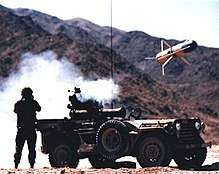
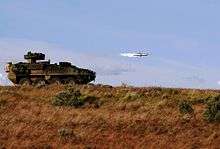
TOW is designated as a BGM by the U.S. military: a multiple launch environment (B) surface attack (G) guided missile (M). The B launch environment prefix is used only when the system can be used essentially unmodified when launched from a variety of launch platforms.
The M151 and M220 launchers are used by infantry, but can also be mounted on a number of vehicles, including the M151 jeep, the M113 APC, the M966 HMMWV and the M1045 HMMWV (which replaced the M966). These launchers are theoretically man-portable, but are quite bulky. The updated M151 launcher was upgraded to include thermal optics to allow night time usage, and had been simplified to reduce weight. The M220 was specifically developed to handle the TOW-2 series.
TOW systems have also been developed for vehicle specific applications on the M2/M3 Bradley IFV/CFV, the LAV-AT, the M1134 Stryker ATGM carrier, and the now retired M901 ITV (Improved TOW Vehicle); they are generally referred to as TOW Under Armor (TUA).
In helicopter applications, the M65 system used by the AH-1 series is the primary system deployed, but the XM26 system was developed for the UH-1, and a system was put into development for the later canceled AH-56 helicopter. TOW has also been used with AH.1 (TOW) and AH.7 variants of Westland Lynx helicopters, with the attachment of two pylons, each carrying four missiles.
The M41 TOW improved target acquisition system (ITAS) is a block upgrade to the M220 ground/high-mobility multipurpose wheeled vehicle (HMMWV)-mounted TOW 2 missile system. The TOW ITAS is currently being fielded to airborne, air assault, and light infantry forces throughout the active and reserve components of the U.S. Army and U.S. Marine Corps (where it is called the SABER). The ITAS, in addition to providing better anti-armour capabilities to antitank units, also has capabilities that make it an integral part of the combined arms team. Even when organized in heavy—light task forces, where the preponderance of antiarmor capabilities traditionally has resided in the heavy elements, TOW ITAS-equipped antitank units can not only destroy threat targets but also provide superior reconnaissance, surveillance, and target acquisition (RSTA), rear area protection, and urban operations capabilities.
The TOW ITAS consists of three new line replaceable units: the target acquisition subsystem (TAS), the fire control subsystem (FCS), and the lithium battery box (LBB); a modified TOW 2 traversing unit; the existing TOW launch tube and tripod; and a TOW Humvee modification kit. The TAS integrates into a single housing the direct view optics and missile tracker, a second-generation forward looking infrared (FLIR) night vision sight (NVS), and a laser rangefinder. TAS electronics provide automatic boresighting for these components, eliminating both tactical collimation and 180-day verification requirements. The integral cooling system for the IR optics is a modern SADA-II electrically powered cryocooler, removing the need to carry a supply of high-pressure coolant gas cartridges as was necessary for the previous AN/TAS-4 and AN/TAS-4A night sights.
The most recent addition to the ITAS system is the ITAS-FTL (far target location), which incorporates a new module called PADS (position attitude determination subsystem), a device that attaches to the top of the ITAS sighting unit and uses differential GPS tracking to relay precise coordinate data to the operator.[17]
Service history
In 1968, a contract for full-scale production was awarded to Hughes, and by 1970 the system was being fielded by the U.S. Army. When adopted, the BGM-71 series replaced the M40 106 mm recoilless rifle and the MGM-32 ENTAC missile system then in service. The missile also replaced the AGM-22B then in service as a heliborne anti-tank weapon.
1972: Vietnam: first combat use
On 24 April 1972, the U.S. 1st Combat Aerial TOW Team arrived in South Vietnam; the team's mission was to test the new anti-armor missile under combat conditions.[18] The team consisted of three crews, technical representatives from Bell Helicopter and Hughes Aircraft, members of the United States Army Aviation and Missile Command, and two UH-1B helicopters; each mounting the XM26 TOW weapons system, which had been taken from storage. After displacing to the Central Highlands for aerial gunnery, the unit commenced daily searches for enemy armor.[18] On 2 May 1972, U.S. Army UH-1 Huey helicopters firing TOWs destroyed North Vietnamese People's Army of Vietnam (PAVN) tanks near An Loc. This was heralded as the first time a U.S. unit neutralized enemy armour using American-designed and built guided missiles (in this case, against a captured American-made M41 operated by the PAVN).[19] On 9 May, elements of the PAVN's 203rd Armored Regiment assaulted Ben Het Camp held by Army of the Republic of Vietnam (ARVN) Rangers. The Rangers destroyed the first three PT-76 amphibious light tanks of the 203rd, thereby breaking up the attack.[20][21] During the battle for the city of Kontum, the TOW missile had proven to be a significant weapon in disrupting PAVN tank attacks within the region. By the end of May, BGM-71 TOW missiles had accumulated 24 confirmed kills of both PT-76 light and T-54 main battle tanks.[20][21]
On 19 August, the ARVN 5th Infantry Regiment, 2nd Division abandoned Firebase Ross in the Que Son Valley, 30 miles (48 km) southwest of Da Nang, to the PAVN 711th Division. A dozen TOW missiles were left with abandoned equipment and fell into PAVN hands.[22]
1982: Lebanon War
The Israel Defense Forces used TOW missiles during the 1982 Lebanon War. On 11 June, Israeli anti-tank teams armed with TOW ambushed Syrian armoured forces and destroyed a number of Syrian Soviet-made T-72 tanks. Estimates vary regarding the number of T-72s destroyed by TOWs (vs. the number destroyed by Merkava MBTs), with the lower end at nine and the high end attributing "the majority" of the 30 T-72s destroyed by Israeli forces in the war to Yossi Peled's anti-tank TOW units.[23] This was probably the first encounter of the American anti-tank missile with the newer Soviet tank.[24]
Iran–Iraq War
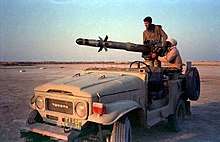
In the Iran–Iraq War of the 1980s, the Islamic Republic of Iran Army used TOW missiles purchased before the Iranian Revolution in 1979, as well as those purchased during the Iran–Contra affair.
Of the 202 AH-1J Internationals (export variant of the AH-1J SeaCobra) that Iran purchased from the US, 62 were TOW-capable. Iranian AH-1Js managed to slow down Iraqi tank advances into Iran. During the "dogfights" between Iranian SeaCobras and Iraqi Mil Mi-24s, Iranians achieved several "kills", usually using TOW missiles.[25]
1991: Persian Gulf War
TOW was used in multiple engagements during Operation Desert Storm in the 1991 Persian Gulf War. During the war, both the M2 Bradley Infantry fighting vehicle (IFV) and the M3 Bradley Cavalry Fighting Vehicle (CFV) carried TOW missiles. The M2 can also carry seven additional rounds, while the M3 can carry twelve.[26] The M2 and M3 medium-weight Bradley Fighting Vehicles destroyed more Iraqi tanks during the war than the M1A1 Abrams heavy Main Battle Tanks.[27]
The British Army also deployed TOW-armed, Westland Lynx helicopters to the conflict, where they were used to attack Iraqi armoured vehicles. This was the first recorded use of the missile from a British helicopter.
1993: Somalia
On 5 June, 24 Pakistani soldiers were slaughtered by members of Mohamed Farrah Aidid's Habr Gidr militia; some were skinned.[28] Subsequently, the United Nations called for the arrest of those responsible. Weeks later they would formally place the blame on Aidid, leader of the Habr Gidr clan. Subsequently, U.N. troops hunted Aidid. Incidents between the two sides worsened, with fighting back and forth. On 12 July, three months prior to the Battle of Mogadishu, the United Nations and United States attempted to defeat Aidid's organization by attacking a strategy meeting of his native Habr Gidr clan under Operation Michigan. The Washington Post'' described the event as a "slaughter" in which a "half-dozen" AH-1 Cobra attack helicopters fired 16 TOW missiles and 2,000 rounds from their 20 mm cannons into the meeting of the elders and senior combat commanders. The first TOW missile destroyed the stairs, preventing escape. In the aftermath, it was revealed that Aidid was not in the meeting. The Red Cross claimed that 54 people had been killed, Admiral Jonathan T. Howe reported that 20 had died, while Aidid's Somali National Alliance produced a list of 73 people whom they claimed had been killed.[29]
2001: War in Afghanistan
TOW missiles were used during the War in Afghanistan.[30]
2003: Iraq War
10 Humvee-mounted TOW missiles were used by U.S. forces in Iraq during the 22 July 2003 assault that killed Uday and Qusay Hussein.[31] Although TOW missiles are generally used against armored vehicles, these missiles were used on the house the two men were in.
2011: Syrian Civil War
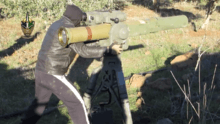
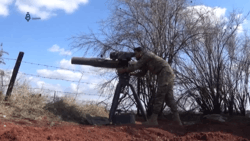
The weapon was spotted as early as April 2014 in at least two videos that surfaced showing Syrian opposition forces in the Syrian Civil War using BGM-71 TOWs, a weapon previously not seen in use by the opposition.[32] Such a video, showing a BGM-71E-3B with the serial number removed, can be seen in a 27 May 2014 episode of the PBS series Frontline.[33]
In February 2015, The Carter Center listed 23 groups within the Southern Front of the Free Syrian Army that have been documented using US supplied TOWs.[34]
A sudden influx of TOWs were supplied in May 2015, mostly to Free Syrian Army affiliated factions, but also independent Islamist battalions; as a requirement of being provided TOWs, these Syrian opposition groups are required to document the use of the missiles by filming their use, and are also required to save the spent missile casings.[35] Groups provided with TOWs include the Hazzm Movement, the 13th Division, 1st Coastal Division, Syria Revolutionaries Front, Yarmouk Army, Knights of Justice Brigade, and the 101st Division.[36] Free Syrian Army battalions widely and decisively used TOWs in the 2015 Jisr al-Shughur offensive.[37][38][39] Russia attempted a rescue operation after a Su-24M was shot down at the Syria–Turkey border on 24 November 2015, a video of Free Syrian Army 1st Coastal Division using a TOW missile to destroy a disabled Russian helicopter on the ground after its crew had retreated was posted on YouTube.[40] In October 2015, Saudi Arabia delivered 500 TOW missiles to anti-Assad rebels.[41] A video produced through Bulgarian Television provides evidence of non rebel use of this weapon by Islamic affiliated fighters.[42]
Reports indicate that small number of TOW missiles have ended up in the hands of al-Qaeda in Syria and Islamic State of Iraq and the Levant.[43][44]
In August 2016 footage of the Syrian military inspecting a captured BGM-71E missile system in Bani Zeit district, Aleppo, was leaked online.[45] On 2 September 2016, rebels released a video of a BGM-71 TOW destroying a French-manufactured Syrian Air Force Aérospatiale Gazelle as it was landing on an airstrip near Khattab in Northern Hama.[46]
Reports say that the TOW missile has successfully hit Russian T-90s in Syria, which are equipped with active defences designed to defeat such missiles.[47] However, a Russian report claims the tank shows "very little damage" and was still operable.[48]
Variants
Raytheon has taken over for Hughes in recent years, and now handles production of all current variants, as well as TOW development.
| Designation | Description | Length | Diameter | Wingspan | Launch weight | Warhead | Armor penetration (est.) | Range | Speed |
|---|---|---|---|---|---|---|---|---|---|
| XBGM-71A/BGM-71A | Hughes Tube launched Optically tracked Wire command link guided (TOW) Missile | 1.16 m | 0.152 m | 0.46 m | 18.9 kg | 3.9 kg (2.4 kg HE) HEAT | 430 mm (exact value) | 65–3,750 m (2.33 mi) | 278 m/s |
| BGM-71B | BGM-71A variant; improved range | ||||||||
| BGM-71C | BGM-71B variant; Improved TOW (ITOW) w/ improved shaped-charge warhead | 1.41 m (probe extended) 1.17 m (probe folded) |
19.1 kg | 630 mm (exact value) | |||||
| BGM-71D | BGM-71C variant; TOW-2, improved guidance, motor and enlarged main warhead | 1.51 m (probe extended) 1.17 m (probe folded) |
21.5 kg | 5.9 kg (3.1 kg HE) HEAT |
900 mm | ||||
| BGM-71E | BGM-71D variant; TOW-2A optimized to defeat reactive armor with tandem warheads | 22.6 kg | 900 mm (behind a layer of ERA) | ||||||
| BGM-71F | BGM-71D variant; TOW-2B top-down attack variant using explosively formed penetrators | 1.168 m | 6.14 kg EFP[49] | no data | 200–4,500 m (2.8 mi)[N 1][50] | ||||
| BGM-71G | BGM-71F variant; different AP warhead; not produced | no data | no data | no data | no data | no data | |||
| BGM-71H | BGM-71E variant; "bunker buster" variant for use against fortified structures | no data | no data | no data | 200 mm double reinforced concrete[50] | 65–4,200 m (2.6 mi)[50] |
Original armor penetration estimates were 600 mm for BGM-71A/B and 700–800 mm for BGM-71C. However, according to a now declassified CIA study, the true penetration values against a vertical target are much lower—just 430 mm for basic TOW and 630 mm for Improved TOW.[51]
Time to target at maximum range is 20 seconds therefore giving an average speed of 187.5 m/s.[52]
International
Iran has reverse engineered the type from examples acquired before 1979 and currently manufactures duplicate TOW missiles. These carry the Iranian designation of Toophan.[53]
Operators
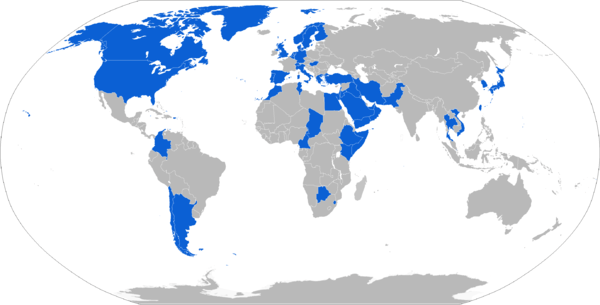
Current


.svg.png)


.svg.png)



































.svg.png)










Former
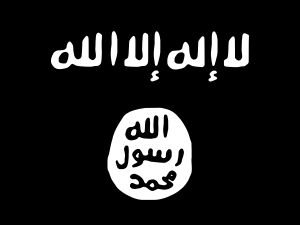

Gallery
 Launch, trailing wire is clearly noticeable.
Launch, trailing wire is clearly noticeable. A US Marine carrying a BTM-71E practice round.
A US Marine carrying a BTM-71E practice round. A TOW fired from a US Marine Corps Humvee during training, in 2014.
A TOW fired from a US Marine Corps Humvee during training, in 2014. An M901 ITV in Israel, in 2005.
An M901 ITV in Israel, in 2005. A Greek TOW on the ground.
A Greek TOW on the ground. Greek soldiers manning a TOW unit.
Greek soldiers manning a TOW unit. The sight on a Hellenic Army BGM-71 TOW.
The sight on a Hellenic Army BGM-71 TOW.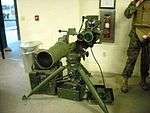 A ground-mounted TOW system.
A ground-mounted TOW system. A BGM-71 TOW-armed Wiesel AWC of the German Army.
A BGM-71 TOW-armed Wiesel AWC of the German Army. US Army soldiers assembling an ITAS (Improved Target Acquisition System) TOW Missile system, in Iraq, in 2007.
US Army soldiers assembling an ITAS (Improved Target Acquisition System) TOW Missile system, in Iraq, in 2007.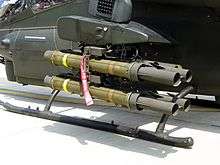 An AH-1W SuperCobra of the Republic of China Army armed with an XM65 launcher and four TOW missiles.
An AH-1W SuperCobra of the Republic of China Army armed with an XM65 launcher and four TOW missiles.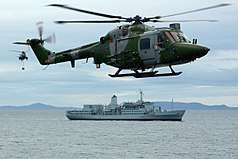 A Lynx AH.7 of the Royal Marines fitted with TOW missile launchers.
A Lynx AH.7 of the Royal Marines fitted with TOW missile launchers.
See also
- MAPATS
- Swingfire
- HOT (missile)
- AT-5 Spandrel
- AT-4 Spigot
- AT-14 Kornet
- Shershen
- M47 Dragon
- FGM-148 Javelin
- ALAS (missile)
- HJ-8
- AGM-179 JAGM
- History of UAVs decoys
- List of U.S. Army Rocket Launchers By Model Number
Notes
- 4,200m for TOW-2B Aero, 3,750 m for TOW-2B.
References
- FUNKER530 - Veteran Community & Combat Footage (28 December 2011). "DOUBLE BARREL TOW MISSILE HEADED FOR INSURGENTS - NO SLACK". Archived from the original on 25 November 2013 – via YouTube.
- "Etat islamique: comment les djihadistes emploient les missiles antichars pour appuyer leurs offensives". France-Soir (in French). 4 May 2017. Archived from the original on 6 September 2018. Retrieved 6 September 2018.
- "Missile Procurement, Army (FY2021)" (PDF).
- Pattie, Geoffrey. "Weapons and Equipment (Costs)". millbanksystems. millbanksystems. Archived from the original on 17 June 2016. Retrieved 21 May 2016.
- ARG. "TOW Anti-Tank Guided Missile - Military-Today.com". www.military-today.com. Archived from the original on 22 September 2017.
- "Official US Army history of TOW (9th paragraph)". Archived from the original on 3 July 2015.
- "M-220 Tube-launched, Optically-tracked, Wire-guided missile (TOW)". fas.org. Archived from the original on 3 November 2013. Retrieved 2 November 2013.
- "The Augusta Chronicle: Local & World News, Sports & Entertainment in Augusta, GA". The Augusta Chronicle. Archived from the original on 3 April 2015.
- FM 23-24 TOW Weapon System, Headquarters, Department of the Army, 17 August 1994, p. 1-11, "The launch motor is a solid fuel rocket booster that burns entirely inside the launch tube," p. 1-13 Table 1-2 gives time of exit at launch +.05 seconds.
- Liden, M. "TOW missile - beginning to end". www.aircav.com. Archived from the original on 10 October 2017.
- Gunston, p. 157.
- "Archived copy". Archived from the original on 10 December 2009. Retrieved 12 January 2010.CS1 maint: archived copy as title (link)
- John Pike. "TOW FIRE AND FORGET (TOW-F&F)". Archived from the original on 27 December 2005.
- "Hughes / Raytheon BGM-71 TOW / TOW-2 Heavy Anti-Tank (AT) Weapon System - United States". Archived from the original on 9 February 2019.
- Raytheon Company (8 October 2012). "Raytheon awarded $349 million US Army contract for TOW missiles". Archived from the original on 16 November 2012.
- "Air Weapons: TOW Fades". Archived from the original on 27 September 2013.
- "TOW System Upgrade Goes To Troops In Afghanistan". Archived from the original on 15 August 2017.
- Starry p. 215
- McKenna, Thomas P. (2011). "11. A New Team for the Defense". Kontum: The Battle to Save South Vietnam. Battles and Campaigns. University Press of Kentucky. p. 143. JSTOR j.ctt2jcmsd.
- Starry p. 215–217
- Dunstan
- U.S. confirms enemy captured secret missiles. Washington Post News Service 22 August 1972
- Pollack, Kenneth M. (2004). Arabs at War: Military Effectiveness, 1948-1991. University of Nebraska Press. p. 660. ISBN 0803287836.
- עפר שלח ויואב לימור, "שבויים בלבנון, האמת על מלחמת לבנון השנייה", הוצאת ידיעות ספרים, 2007, עמוד 327 (Hebrew)
Ofer Shelah and Yoav Limor, "Captives in Lebanon – The Truth about the Second Lebanon War", 2007 – page 327. - "[2.0] Second-Generation Cobras". Archived from the original on 10 January 2016.
- "M2 Bradley – Infantry Fighting Vehicle (IFV) – History, Specs and Pictures – Military Tanks, Vehicles and Artillery". Archived from the original on 1 July 2014.
- "The M2 Bradley Infantry Fighting Vehicle". TankNutDave.com. Archived from the original on 31 May 2014.
- Online, Philadelphia. "Philadelphia Online - Blackhawk Down". inquirer.philly.com. Archived from the original on 20 August 2016.
- "U.S. War Crimes in Somalia". Archived from the original on 3 March 2016. Retrieved 18 April 2014.
- Rubin, Lyle Jeremy (12 April 2016). "As a Former Marine, America's War-Making Haunts Me—It Should Haunt Our Politicians Too". The Nation. Archived from the original on 2 January 2017. Retrieved 30 October 2016.
I remember watching about a half dozen Marines unleash their fury on a village because stray rounds were heard popping near our base, the unit was about to head home, and there were weapon systems and ammunition yet to be deployed. First they returned fire with their M-4 rifles. Then the M249 light machine gun. Then the M240 machine gun. Then the MK-19 grenade launcher. Then the AT4 anti-tank weapon. Then the FGM-148 Javelin anti-tank missile. Then the vehicle-mounted BGM-71 TOW anti-tank missile.
- "Chronology: How the Mosul raid unfolded". BBC News. 23 July 2003. Archived from the original on 11 January 2009. Retrieved 16 June 2015.
- Syria: Arming the Rebels. Frontline (Online Video). PBS. 27 May 2014. Event occurs at 8:07. Archived from the original on 8 June 2015. Retrieved 15 June 2015.
- "Syria Countrywide Conflict Report No. 5" (PDF). The Carter Center. February 2015. p. 22. Archived (PDF) from the original on 29 April 2015. Retrieved 28 May 2015.
- Mustafa, Hasan (8 May 2015). "THE MODERATE REBELS: A GROWING LIST OF VETTED GROUPS FIELDING BGM-71 TOW ANTI-TANK GUIDED MISSILES". www.HasanMustafas.wordpress.com. Archived from the original on 12 June 2016. Retrieved 15 May 2015.
- Lucas, Scott (9 May 2015). "Syria: The 9 Insurgent Groups with US-Made TOW Anti-Tank Missiles". EA WorldView. Archived from the original on 29 March 2015. Retrieved 15 May 2015.
- Gutman, Roy; Alhamadee, Mousab (3 May 2015). "Rebel worry: How to control Islamists if Assad is pushed from northern Syria". Ledger-Enquirer. The McClatchy Company. Archived from the original on 7 May 2015. Retrieved 4 May 2015.
- Barnard, Anne; Saad, Hwaida (25 April 2015). "Islamists Seize Control of Syrian City in Northwest". The New York Times. Archived from the original on 25 May 2015. Retrieved 27 April 2015.
Other video images posted by fighters and antigovernment activists showed insurgents, including some with Fursan al-Haq, a Free Syrian Army group, using what appeared to be guided antitank missiles to blow up armored vehicles in the battles in Idlib Province in recent days.
- "In Syria, the Stakes Are High for a Rebel Offensive". Stratfor. 24 April 2015. Archived from the original on 18 May 2015. Retrieved 25 April 2015.
- "Syria rebels destroy Russian helicopter". NOW Media. Archived from the original on 4 January 2016.
- "Saudi Arabia just replenished Syrian rebels with one of the most effective weapons against the Assad regime Archived 3 November 2016 at the Wayback Machine". Business Insider. 10 October 2015.
- "I wonder why this is being Censored?". 22 May 2017. Archived from the original on 17 September 2017.
- "Syrian sniper: US TOW missiles transform CIA-backed Syria rebels into ace marksmen in the fight against Assad Archived 6 March 2016 at the Wayback Machine". International Business Times. 30 October 2015.
- "ISIS used US-made anti-tank missiles near Palmyra Archived 3 October 2016 at the Wayback Machine". Business Insider. 9 June 2015.
- Sircliffe (1 August 2016), AnnaNews – Exclusive: Syrian Army Captured American Arms Depot, archived from the original on 2 January 2017, retrieved 12 August 2016
- "YouTube". www.youtube.com. Archived from the original on 2 January 2017.
- TOW Missile Hits a T-90 Tank with ‘Soft-Kill’ (SHTORA) APS and Reactive Armor Archived 28 February 2016 at the Wayback Machine – Defense-Update.com, 27 February 2016
- "Archived copy". Archived from the original on 5 August 2018. Retrieved 4 August 2018.CS1 maint: archived copy as title (link)
- "Archived copy" (PDF). Archived (PDF) from the original on 26 September 2013. Retrieved 22 September 2013.CS1 maint: archived copy as title (link)
- TOW Weapon System Archived 7 April 2014 at the Wayback Machine
- "Archived copy" (PDF). Archived (PDF) from the original on 1 November 2013. Retrieved 31 October 2013.CS1 maint: archived copy as title (link)
- "U.S. INTELLIGENCE AND SOVIET ARMOR" Paul F. Gorman, page 18 Archived 14 June 2007 at the Wayback Machine
- Mikhail Barabanov (23 August 2006). "Hezbollah's Examination". Kommersant. Archived from the original on 8 January 2014. Retrieved 8 January 2014.
- Small Arms Survey (2015). "Half a Billion and Still Counting: Global Firearms Stockpiles" (PDF). Small Arms Survey 2011: Profiling the Problem. Oxford University Press. p. 74. Archived from the original on 20 August 2018. Retrieved 29 August 2018.
- "Archived copy" (PDF). Archived (PDF) from the original on 11 July 2011. Retrieved 31 August 2010.CS1 maint: archived copy as title (link)
- "Puolustusvoimat". Archived from the original on 15 May 2007. Retrieved 20 April 2007.
- "قوات الحشد الشعبي تتسلح بصواريخ طوفان ( تاو ) المتطورة". www.arabic-military.com. Archived from the original on 24 July 2015.
- Army Recognition Alain Servaes. "Military army ground forces equipment Morocco Army". Archived from the original on 1 January 2008.
- "Government of Morocco – TOW 2A, Radio Frequency (RF) Missiles (BGM-71-4B-RF) and Support". Defense Security Cooperation Agency. 8 December 2016. Archived from the original on 11 December 2016. Retrieved 9 December 2016.
- "Taiwan and Oman order Raytheon's TOW anti-tank guided missile". Army Recognition. 4 May 2018. Archived from the original on 4 May 2018. Retrieved 10 May 2018.
- "Foreign Military Sale: Pakistan – TOW-2A Anti-Armor Guided Missiles". Archived from the original on 1 May 2011.
- "Stormer 30 vehicle from behind: 2X TOW can be seen on each side of the vehicle". Archived from the original on 27 August 2018. Retrieved 4 August 2018.
- "Gill-antitankraket". Defensie.nl. Ministerie van Defensie. Archived from the original on 13 February 2018. Retrieved 13 February 2018.
- van Hoof, H.A.L. (22 June 2001). "nr. 45 BRIEF VAN DE STAATSSECRETARIS VAN DEFENSIE". Archived from the original on 13 February 2018. Retrieved 13 February 2018.
- van Westerhoven, Leo. "Netherlands fire their first GILL". Dutch Defence Press. Archived from the original on 13 February 2018. Retrieved 13 February 2018.
Sources
- The TOW Family
- TOW Improved Target Acquisition System (ITAS)
- The TOW Anti-Tank Missile in Vietnam
- Dunstan, Simon (1982). Vietnam Tracks-Armor in Battle. Osprey Publications. ISBN 0-89141-171-2.
- Gunston, Bill (1983). An Illustrated Guide to Modern Airborne Missiles. London: Salamander Books Ltd. ISBN 0-86101-160-0.
- Starry, Donn A. General. Mounted Combat in Vietnam. Vietnam Studies; Department of the Army. First printed 1978-CMH Pub 90-17.
External links
| Wikimedia Commons has media related to BGM-71 TOW. |
- From early developmental XBGM-71 testing to the BGM-71A TOW
- TOW project history at Redstone Arsenal
- www.fas.org
- More information at Designation Systems.net
- The Early TOW Missile Story & Photos
- Tank vs Missile – 1974 article
- Iranian Copies of the TOW and DRAGON
- Discovery Channel program on "Modern Missiles" with best video information on TOW today. TOW part starts at two minutes
- TOW 2A Wireless
- TOW 2B Aero Wireless
- TOW Bunker Buster Wireless
- Tube-Launched, Optically-Tracked, Wire-Guided (TOW) Missiles